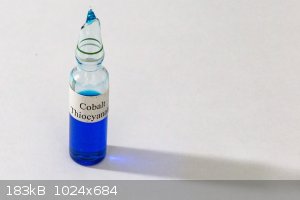
Foeskes - 8-9-2017 at 16:27
Last week, I went to my local school supply store (they sell lots of chemicals there) and bought ammonium dichromate, the bottle looks like it has
been there for many years. After I got home and opened it, I found out that it isn't ammonium dichromate but a clear solid crystal that looks like
sodium thio sulfate when I poured it out a bit of liquid came too, so it's probably hygroscopic. It's a somewhat strong reducing agent reacting with
permanganate to form manganese dioxide and reducing hypochlorite with a exothermic reaction. However unlike thiosulfate it reacts with dilute sulfuric
acid to form a deep red compound (kinda like permanganate mixed with MnO2) with no gas produced it doesn't seem to be exothermic either.
What might this possibly be?
EDIT: it's likely thiocyanate, it reacts with iron(III) sulfate forming a blood red solution. Its dissolution is endothermic.
[Edited on 9-9-2017 by Foeskes]
[Edited on 9-9-2017 by Foeskes]
ave369 - 9-9-2017 at 00:18
Is thiocyanic acid deep red? Or is it just iron contamination in sulfuric acid?
Foeskes - 9-9-2017 at 01:25
I'm starting to think its not it, since cobalt(II) is SUPPOST to make a blue compound but I got a deep red compound. The red also seems to have low
solubility in water.
nezza - 9-9-2017 at 03:36
It sounds like potassium thiocyanate. It is quite hygroscopic and old bottles will have liquid in them unless extremely well sealed.
j_sum1 - 9-9-2017 at 04:02
I would have thought ammonium thiosulfate was more likely -- at least a more likely mislabel.
You could test with NaOH to see if it is an ammonium salt. Maybe do a flame test if that comes up negative.
[Edited on 9-9-2017 by j_sum1]
Foeskes - 9-9-2017 at 04:21
Ok, I reacted it with NaOH. The reaction definitely produced ammonia.
Any more test for thiocyanate?
j_sum1 - 9-9-2017 at 05:10
Well the rust-blood complex with Fe3+ is as far as I know unique. Nothing else reacts with ferric in that way.
Is it possible that your Co is impure and the normal colour is masked?
Edit
I note that Co(SCN)2 is a bright red colour. A (very) quick search gave me nothing on the complex. I think this means the puzzle is solved.
[Edited on 9-9-2017 by j_sum1]
nezza - 13-9-2017 at 23:46
Mix some of the solution 50:50 with acetone. Adding cobalt(II) to this solution should give a bright blue complex. Be aware that any iron(III)
contamination may mask the colour. Iron(III) can be removed by the addition of fluoride. Here is a picture of the cobalt(II) thiocyanate complex in
50% acetone.

[Edited on 14-9-2017 by nezza]
woelen - 14-9-2017 at 10:19
If you have access to nitrite, then you can check for thiocyanate as follows:
Dissolve some of the mystery solid in 10% H2SO4 (not HCl)
If it is a thiocyanate, then the solution remains colorless if the H2SO4 does not contain any iron(III).
Add a little amount of solid NaNO2 or a ml or so of highly concentrated NaNO2-solution.
If you have thiocyanate, then a deep red solution is obtained, which slowly decomposes, giving bubbles of gas and a white fume.
